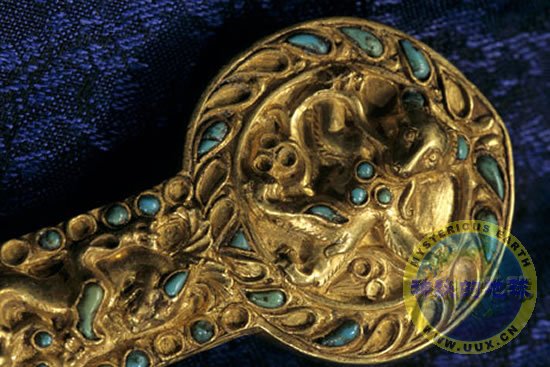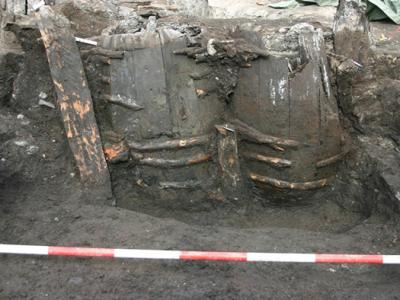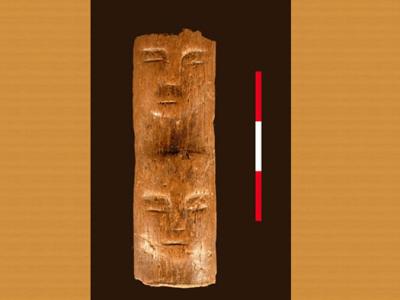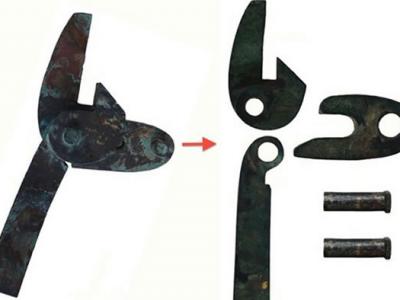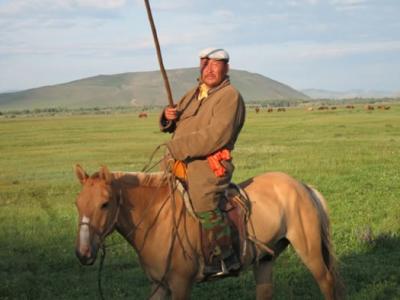"Lost" Afghan Gold Treasures Coming to U.S.
A close view of a dagger from the first century A.D. shows semiprecious turquoise inlaid in the gold hilt. The dagger is part of the fabled "Bactrian hoard" of gold treasures found in northern Afghanistan in 1978 and believed lost until 2003.
A hundred objects from the hoard, along with artifacts from other archaeological sites, will come to the U.S. for the first time next year as part of the traveling exhibit "Afghanistan: Hidden Treasures from the National Museum."
Photograph by Kenneth Garrett © 2007 National Geographic
Kelly Hearn
for National Geographic News
December 20, 2007
Ancient treasures thought lost in the chaos of Afghanistan's modern invasions, wars, coups, and countercoups will be on display in the United States for the first time, starting in May 2008, officials announced today.
The traveling exhibition will showcase more than 200 artifacts from four archaeological sites, including a hundred gold objects from the fabled "Bactrian hoard."
The 2,000-year-old Bactrian treasures were discovered in 1978 in the graves of six nomads who lived in the ancient nation of Bactria, which covered parts of what is now Afghanistan.
Russian-Greek archaeologist Viktor Sarianidi unearthed a trove of gold ornaments—necklaces, belts, rings, and headdresses set with semiprecious jewels—from a site called Tillya Tepe.
(See photos of some of the Bactrian gold treasures that will be on display.)
But the finds were later hidden and eventually thought stolen—until the Afghan government found them stashed in boxes in 2003.
In addition to the Bactrian objects, "Afghanistan: Hidden Treasures from the National Museum" will display a variety of artifacts dating back to 2100 B.C.
The exhibition will include bronze, ivory, and stone sculptures from the former Greek city Aï Khanum, as well as first-century A.D. trade items, many of which were imported from Chinese, Indian, Roman, and East Asian markets.
Cultural "Heroes"
The far-flung origins of the exhibition's pieces underscore Afghanistan's ancient role as a cultural transmission point along the set of trade routes known as the Silk Road, said archaeologist and exhibition curator Fredrik T. Hiebert.
Hiebert helped inventory the Bactrian objects when they were rediscovered in 2003.
"But this exhibit is really about heroism," said Hiebert, who has been funded by the National Geographic Committee for Research and Exploration. (National Geographic News is part of the National Geographic Society.)
"These pieces should not be around today. They are here because people risked their lives to safeguard them."
The artifacts—which are the property of Afghanistan—were once housed in the National Museum of Afghanistan in Kabul.
Before the Soviet Union's invasion in 1979, the country's museum workers stashed away many artifacts.
In the early 1990s, as civil war raged in Kabul, some workers rode bicycles through heavy fighting to salvage what they could from the museum, according to Said T. Jawad, Afghanistan's ambassador to the United States.
Most recently the Taliban set out to destroy statues, paintings, and artifacts considered idolatrous by Islamic fundamentalists—such as depictions of people and animals.
"People were trying to hide animal or human structures from them," the ambassador said.
"Workers at the National Gallery, Afghanistan, used watercolors to cover images in oil paintings. At Afghanistan's film archives, they built false walls to hide archives.
"These were everyday people who earned little money, who risked their lives to save our cultural heritage instead of profiting from it."
In 2003, after a U.S. invasion helped Hamid Karzai become interim president, the leader was inspecting bank vaults at the presidential palace in Kabul.
"He noticed six museum boxes that hadn't been opened," Hiebert, the archaeologist, said. "He wanted to find out if it was the Bactrian gold."
In 2004 Hiebert traveled to Afghanistan to meet officials who had reached out to the National Geographic Society and other organizations for help.
"They said, 'We will open these boxes with you to verify them, if you promise to do a scientific inventory of the objects,'" Hiebert said.
"Then they said, 'If they are the … museum treasures, we'd like to do an international exhibition.'"
Most of the objects in the exhibition are those recovered from the bank boxes, Hiebert said. Ten artifacts were stolen, but a nonprofit group later recovered them, thanks to museum identification marks.
Bigger Than Money
The exhibit has since visited museums in Turin, Italy, and Paris and is currently at De Nieuwe Kerk in Amsterdam until April 20, 2008.
The treasures will begin a 17-month tour of the U.S starting at the National Gallery of Art in Washington, D.C., where they will be on display from May 25 to September 7, 2008.
The Asian Art Museum of San Francisco, the Museum of Fine Arts in Houston, Texas, and the Metropolitan Museum of Art in New York City have also tentatively scheduled stops along the tour.
Some people have criticized National Geographic for what they see as insufficient compensation to Afghanistan.
Lynne Munson, the former deputy chair of the National Endowment for the Humanities—which donated funds to help catalog the artifacts—resigned over the matter in 2005.
"National Geographic Society has been criticized not just by me but by many here and in Kabul for the way they have cut this deal," she said in an email.
But Jawad, the Afghan ambassador, said he believes the deal is fair, adding that "the money isn't the point.
"I've heard the complaints and appreciate those who wish to see Afghanistan get the best possible deal," he said.
"But this is meant to showcase our art and culture and share it with people who send their children to die in our country.
"We didn't ask for money. This is much bigger than the money."
